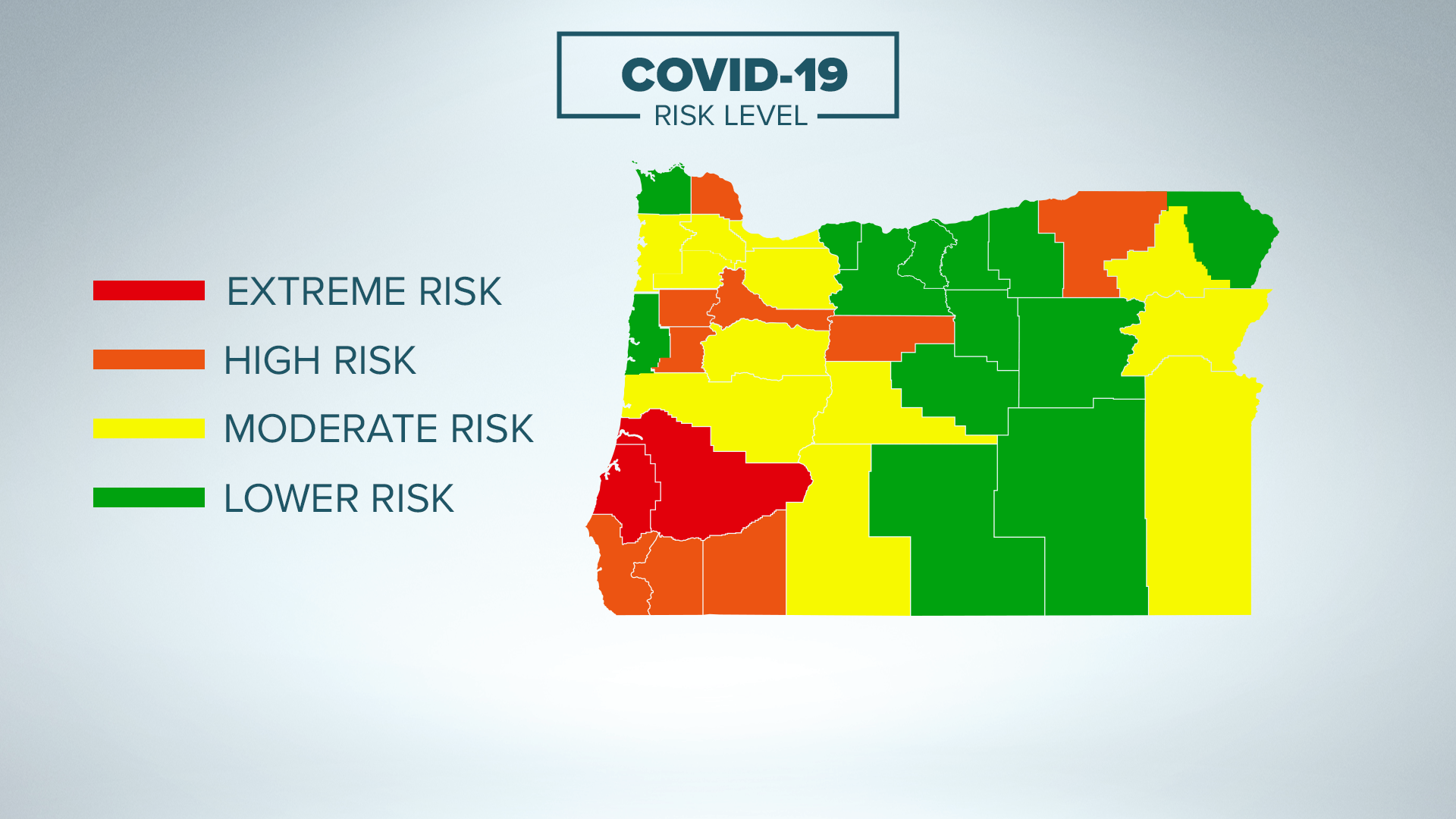PORTLAND, Ore. — Multnomah County, Oregon's most populous, will move from high risk to moderate risk when the state's new COVID-19 risk levels begin on Friday, March 12. The move allows more people at indoor businesses such as restaurants and gyms. Multnomah County will join Washington and Clackamas counties at the moderate level.
Only two Oregon counties, Coos and Douglas, remain in the state's extreme risk level, Gov. Kate Brown announced Tuesday.
"We are largely seeing case rates decline across the state, with the most counties in the lower risk level since the framework was introduced in November," said Brown. "This should serve as a reminder that when we follow the health and safety measures we know work against this virus, we can truly make a difference in infection spread. But, we still have more work to do before we reach the level of community-wide protection we need in order to return to a sense of normalcy. I encourage all Oregonians to keep it up and to get your vaccine when it's available to you."


Multnomah County's chief health officer Dr. Jennifer Vines shared an optimistic outlook about the months to come as more people get vaccinated, even as more contagious variants spread in Oregon and around the world.
"There are a lot of reasons for optimism. I say that as someone who’s naturally an alarmist and had to be vigilant this last year," Dr. Vines told KGW, "We have three effective vaccines. There are questions yet to be answered about variants - these newer more contagious versions of the virus - and how quickly we can vaccinate, whether they hold up against new versions of the virus. That is all yet to be seen.
"But given the way numbers are going, given that we’re seeing fewer outbreaks, given that vaccine supply is expected to sharply increase later this month, I think there are a lot of reasons to be optimistic that through summer and fall things may actually start to feel closer to normal," Vines added.
There will always be a level of uncertainty surrounding the coronavirus, Vines says. The county has changed course on guidance during the past year, therefore Vines says every piece of guidance and advice comes with a caveat that things can change.
"That being said, what I expect to continue to be true is that outdoor interactions are going to be safer than indoor, that the habits people appear to have now around masking are great and continue to offer protection, including against variants. In general - assuming we can roll out this massive vaccine effort - a lot of people should be fairly well protected against this virus come summer."
Vines doesn't advise people make plans for summer until spring is through, but she anticipates summer travel remaining unpredictable because of others states' and countries' case rates and restrictions.
Under Oregon’s latest framework for coronavirus-related restrictions, counties are placed into four risk level categories: extreme risk, high risk, moderate risk and lower risk. The extreme risk designation comes with the strictest restrictions while the lower risk category comes with the least-restrictive rules. The Oregon Health Authority reassigns risk level designations to counties every two weeks, based on the latest data on COVID-19 spread.
Here’s the full list of county risk levels. Counties will remain at these risk levels from March 12 to March 25.
Extreme Risk (2 counties)
- Coos
- Douglas
High Risk (9 counties)
- Benton (Moved from Extreme)
- Columbia
- Curry (Moved from Moderate)
- Jackson (In two-week caution period)
- Jefferson (Moved from Extreme)
- Josephine (Moved from Extreme)
- Marion
- Polk
- Umatilla
Moderate Risk (12 counties)
- Baker (Moved from Lower)
- Clackamas
- Deschutes (Moved from High)
- Klamath (Moved from High)
- Lane (Moved from High)
- Linn
- Malheur (In two-week caution period)
- Multnomah (Moved from High)
- Tillamook (Moved from Lower)
- Union
- Washington
- Yamhill (Moved from High)
Lower Risk (13 counties)
- Clatsop
- Crook (Moved from High)
- Gilliam
- Grant
- Harney (Moved from Moderate)
- Hood River (Moved from Moderate)
- Lake (Moved from Moderate)
- Lincoln
- Morrow (Moved from Moderate)
- Sherman
- Wallowa
- Wasco
- Wheeler
Jackson and Malheur counties are in a two-week caution period because they moved down from the extreme risk level during the previous two-week period but saw their COVID numbers rise in the latest two-week period.
Jackson County qualifies for extreme risk but is given a two-week caution period at high risk, while Malheur County will be in a two-week caution period at moderate risk.
The temporary pause allows businesses to avoid abrupt closures and major changes in how they do business. If case numbers don’t improve in the next two weeks, however, the county will move backward.
Here's a look at which metrics determine the risk level for each county:
Read the full list of rules for each risk category below:

